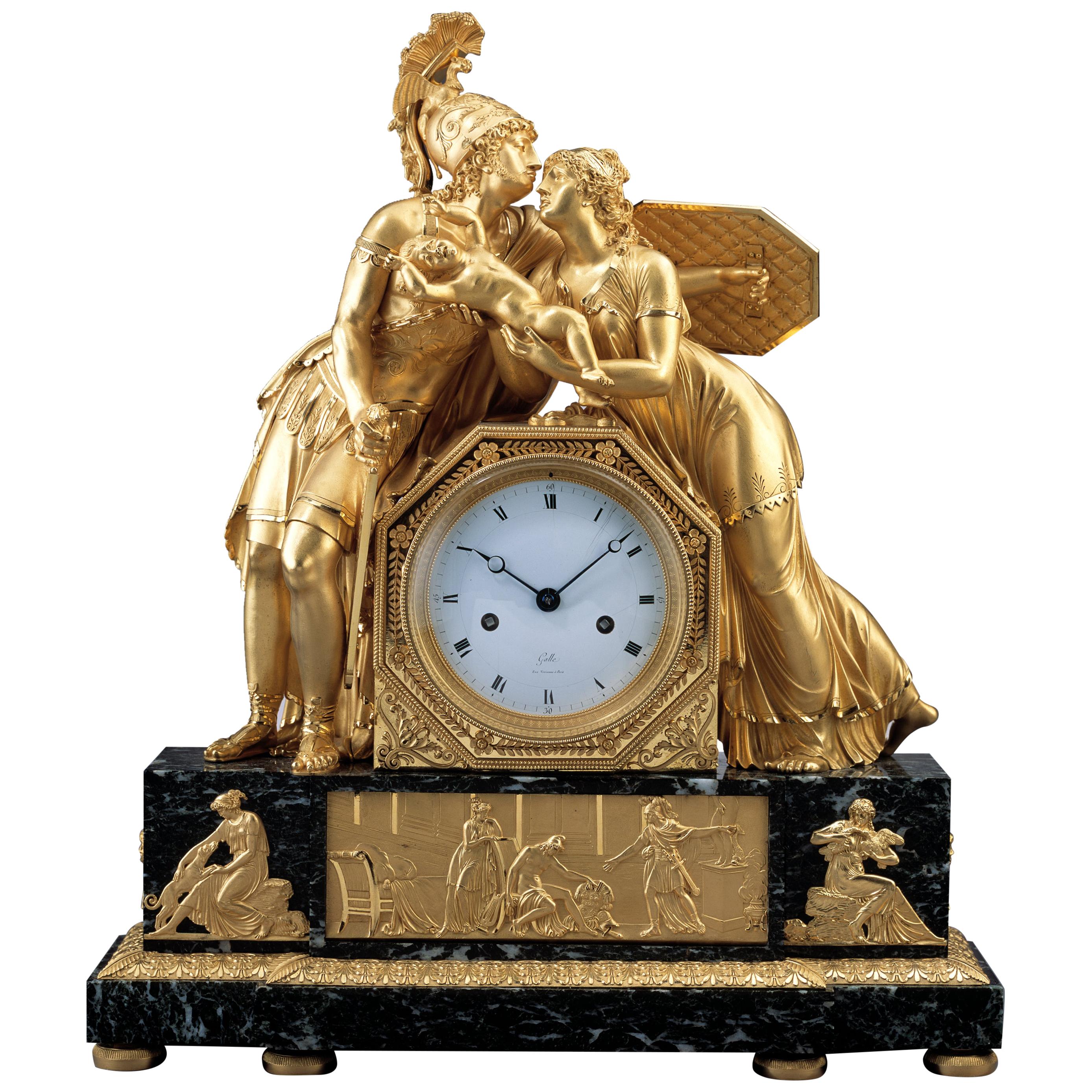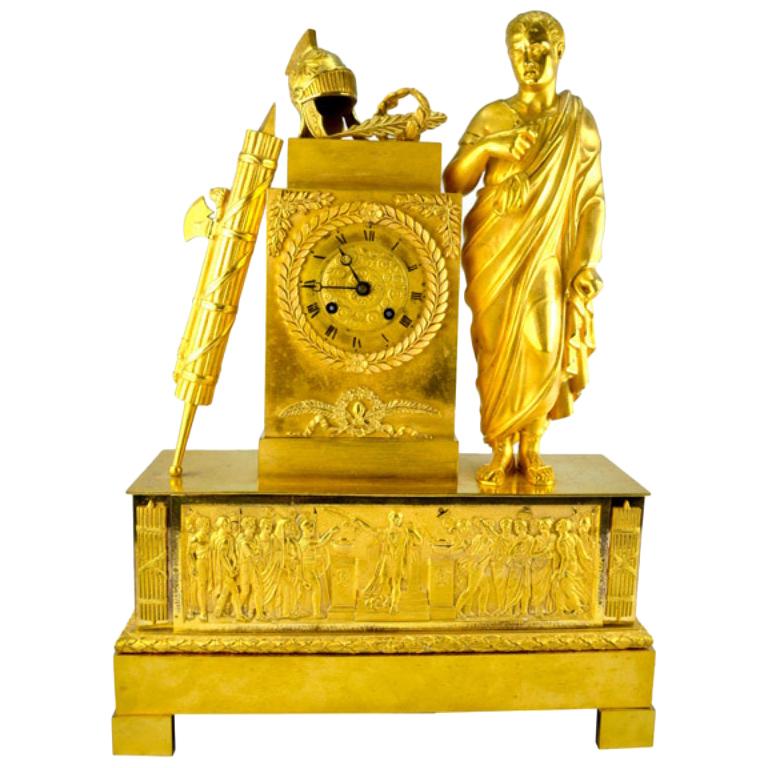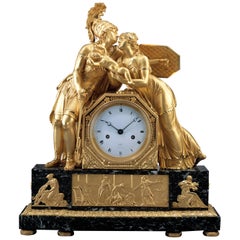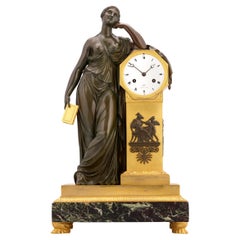Items Similar to Allegorical French Empire clock Titled " Le Sacrifice d’Iphigénie "
Want more images or videos?
Request additional images or videos from the seller
1 of 12
Allegorical French Empire clock Titled " Le Sacrifice d’Iphigénie "
$16,000
£12,233.37
€14,003.15
CA$22,561.93
A$24,561.19
CHF 13,111.37
MX$296,509.92
NOK 164,859.24
SEK 153,225.82
DKK 104,583.21
About the Item
A fine example of a period French Empire mantle clock which depicts the argument between Achilles and Agamemnon in Homer’s Iliad. The case is of matte and burnished gilded bronze, the stepped rectangular base has a large frieze across the front depicting soldiers at war. The clock is adorned with decorative armorial mounts on each side of the frieze. The central rectangular plinth is richly decorated and houses the original dial and silk-string suspension movement, a gilt helmet and sword decorate the top. The white enamel dial with Breguet hands also has a hand indicating the days of the month, the dial is signed ‘Ridel a Paris’. On each side of the plinth are the two standing patinated bronze figures.
The Iliad starts off with a dispute between Agamemnon son of Atreus, and Achilles son of Peleus. Agamemnon is the King of Mycenae and brother to the King of Sparta, Menelaus. Menelaus lost his wife, Helen, to Paris, the son of Priam, and has called upon his brother to go to war with the Trojans to get back Helen. Agamemnon being the hubris person he is, agreed and gathered thousands upon thousands of Greeks to attack Troy. Before the Greeks attacked Troy they overtook another city where Agamemnon took a priest’s daughter, Chryseis, as his prize. Her father, Chryses, tried to ransom his daughter, but Agamemnon laughed at him and sent him away. The priest then prayed to the sun god Apollo. Apollo heard his prayer and he rained arrows upon the Greeks.
Achilles recognized that the reason the men were getting ill was because of Agamemnon’s refusal of the ransom. Achilles called a gathering of the men to explain this phenomenon and Agamemnon was forced to return the priest’s daughter. After Agamemnon lost his prize he decided to take Briseis, Achilles’ woman. Achilles response to this was pure outrage and he then decides to take himself out of the war with the Trojans. This decision determines the rest of the events that occur in the Iliad.
- Creator:Ridel a Paris (Clockmaker),Claude Galle (Clockmaker)
- Attributed to:Claude Galle (Manufacturer)
- Dimensions:Height: 24 in (60.96 cm)Width: 21 in (53.34 cm)Depth: 8 in (20.32 cm)
- Style:Empire (Of the Period)
- Materials and Techniques:
- Place of Origin:
- Period:
- Date of Manufacture:circa 1810
- Condition:Wear consistent with age and use. The gilding which is original, was professionally cleaned.
- Seller Location:Vancouver, CA
- Reference Number:1stDibs: LU4631214743951
About the Seller
4.9
Vetted Professional Seller
Every seller passes strict standards for authenticity and reliability
Established in 1981
1stDibs seller since 2019
165 sales on 1stDibs
Typical response time: 4 hours
- ShippingRetrieving quote...Shipping from: Vancouver, Canada
- Return Policy
More From This Seller
View AllRare French Empire Clock in Gilt and Patinated Bronze Signed Lepaute
By Jean-André Lepaute 1
Located in Vancouver, British Columbia
An extremely rare and important French Empire mantle clock signed by the master clock making dynasty of Jean-Andre Lepaute and his brother Jean-Baptiste Lepaute.
The case, in the form of an antique portal...
Category
Antique Early 19th Century French Empire Mantel Clocks
Materials
Bronze
French Empire Allegorical Clock Depicting Roman Triumph and Power
Located in Vancouver, British Columbia
A figural gilt bronze French Empire clock, ‘Allegory to Triumph and Power’. A Roman emperor stands to the right of the central rectangular plinth housing the movement; atop the plint...
Category
Antique Early 19th Century French Empire Mantel Clocks
Materials
Bronze
French Empire Allegorical Clock of Love Nourishing Life
Located in Vancouver, British Columbia
A figural French Empire clock in gilded bronze representing an allegory on how love nourishes life or “L’Amour alimentant la vie” in French. The clock shows a seated winged Amor refi...
Category
Antique Early 19th Century French Empire Mantel Clocks
Materials
Bronze
French Empire Gilt Bronze Allegorical Clock Depicting the Astronomical Sciences
Located in Vancouver, British Columbia
A fine early 19th century French Empire gilt bronze clock representing an allegory of astronomy; featuring two classically draped maide...
Category
Antique Early 19th Century French Empire Mantel Clocks
Materials
Bronze
French Empire Gilt Bronze Allegorical Clock of the Astronomical Sciences
Located in Vancouver, British Columbia
A fine example of a period French Empire mantle clock in finely chased and gilded bronze made in France in the first quarter of the 19thC. One of the Greek muses with a star atop h...
Category
Antique Early 19th Century French Empire Mantel Clocks
Materials
Bronze
French Empire Allegorical Clock Depicting "Venus Guided by Love" by Lesieur
By Pierre Lesieur
Located in Vancouver, British Columbia
An important and rare French Empire gilt bronze mantel clock depicting "Venus Guided by Love" featuring a case by the noted bronzier Lesieur. The figures and clock plinth sit on a rectangular green marble base topped with a gilt bronze plinth, raised upon four flattened toupie feet.
The round enamel dial, signed “Lesieur à Paris”, indicates the Roman numeral hours and minute graduations. It is housed in a finely chased bronze altar whose pediment is decorated with egg and dart friezes, and be-ribboned torches on either side the façade is adorned with applied stylized butterfly and lyre motifs. The sides feature be-ribboned flower wreaths, and the plinth a leaf frieze. Two fine gilt bronze figures depict a winged and semi-nude cupid who is pointing to the time, while addressing Venus who is clothed in antique robes...
Category
Antique Early 19th Century French Empire Mantel Clocks
Materials
Bronze
$16,875 Sale Price
25% Off
You May Also Like
French Early 19th Century Empire Gilt Bronze Mantel Clock by Claude Galle
By Claude Galle
Located in Worpswede / Bremen, DE
Claude Galle, (1759–1815, master in 1786) is one of the most renowned bronziers active during the Napoleonic period, such as Pierre-Philippe Thomire, André-Antoine Ravrio and Louis-S...
Category
Antique Early 1800s French Empire Mantel Clocks
Materials
Marble, Bronze
Odysseus and Theseus French Empire Mantle Clock by André Antoine Ravrio
Located in New Orleans, LA
Odysseus and Theseus French Empire Mantel Clock
André Antoine Ravrio
Circa 1800
This monumental Empire mantel clock by André Antoine Ravrio, whose case is crafted entirely of gilded...
Category
Antique Early 19th Century French Empire Mantel Clocks
Materials
Bronze
French Empire Gilt Bronze Clock
Located in London, GB
French Empire gilt bronze clock
French, early 19th century
Measures: Height 38cm, width 27cm, depth 10cm
This fine gilt bronze man...
Category
Antique Early 19th Century French Empire Mantel Clocks
Materials
Ormolu, Bronze
$4,286 Sale Price
30% Off
Meditation French Empire Mantel Clock by Claude Galle
By Claude Galle
Located in New Orleans, LA
Empire Mantel Clock
Claude Galle
Circa 1810
This Empire period mantel clock by Galle exemplifies the sophisticated allegorical artistry of early 19th-century French horology. Repres...
Category
Antique 19th Century French Empire Table Clocks and Desk Clocks
Materials
Marble, Bronze, Enamel
Early 19th Century Empire Mantel Clock by Ledure with Apollo or Eros
By Pierre-Victor Ledure, Claude Hemon
Located in Worpswede / Bremen, DE
The clock is signed on the enamel dial by the famous Parisian bronzier ”Ledure Bronzier à Paris” and the clockmaker ”Hedon Hr" (horloger). Patinated and fully sculpted bronze figure ...
Category
Antique Early 19th Century French Empire Mantel Clocks
Materials
Bronze
Fine Quality French Empire Patinated and Gilt Bronze Clock
Located in New York, NY
A very fine French empire style patinated and gilt bronze mantel clock with neoclassical scene.
Stock number: CC59.
Category
Antique 1870s French Empire Mantel Clocks
Materials
Bronze
More Ways To Browse
French Empire Mantel Clock
French Clocks With Silk Suspension
Patinated Bronze Figures
Trojan War
The Iliad
Claude Galle Bronze
Soldier Clock
Gilded Clock
Antique French Brass Clocks
French Empire Mantel Clock
Rococo Ormolu
French Brass Ormolu
18th Century French Bronze Clock
Gold Antique Clock
French Bronze Sculpture And Clock
19th Century French Empire Mantel Clock
Rare Antique Clock
Rare Antique Clocks













